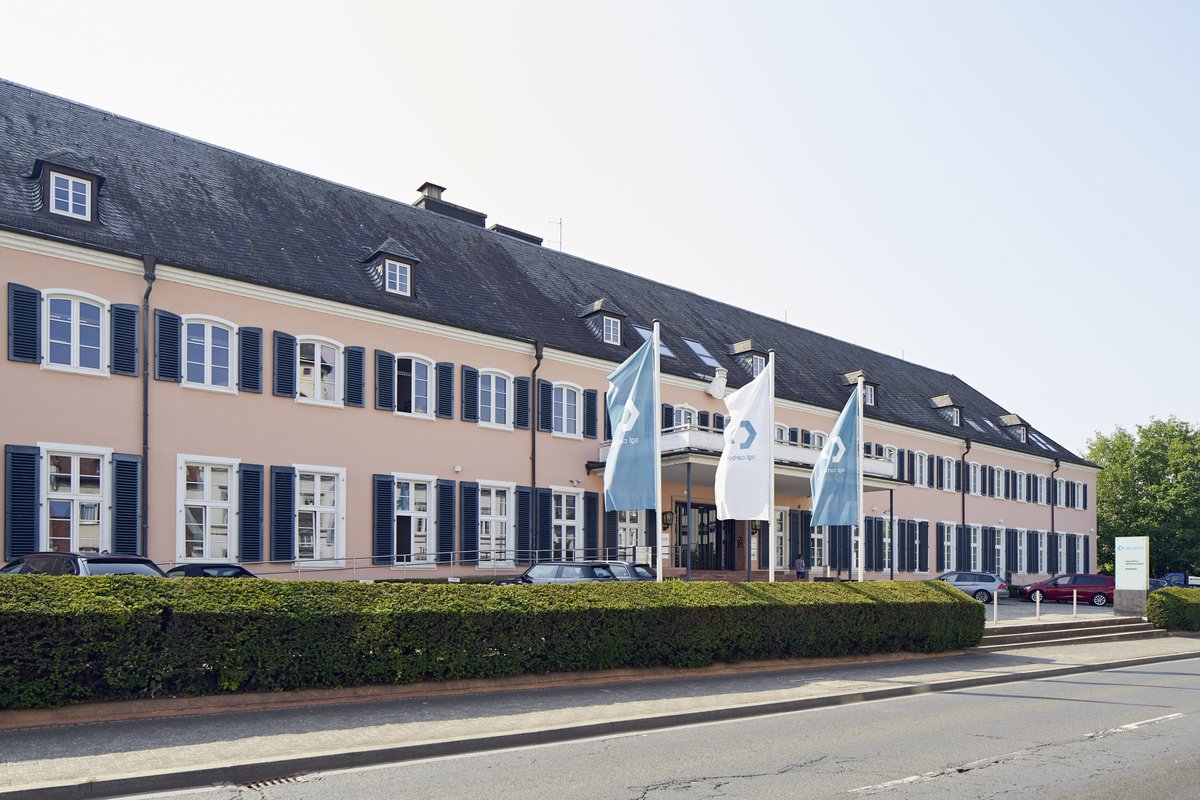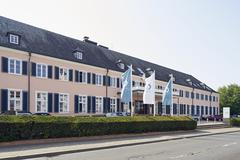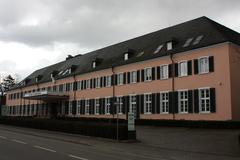
Rheingau Palais Wiesbaden: Visiting Hours, Tickets, and Historical Sites Guide
Date: 14/06/2025
Introduction
The Rheingau-Palais in Wiesbaden stands as a distinguished symbol of the city’s industrial legacy, architectural refinement, and ongoing cultural vibrancy. Built in the 19th century as the headquarters for the prestigious Sektkellerei Söhnlein, one of the region’s most renowned sparkling wine producers, the Palais is a testament to the Rheingau’s economic prosperity and artistic ambition. Over the years, the building has been carefully preserved and adapted, serving today as a hub for business and cultural exploration in the heart of Wiesbaden (deutsches-architekturforum.de, rheingau.com).
This comprehensive guide provides everything you need to know for your visit, including the historical evolution and architectural significance of the Rheingau-Palais, practical visitor information such as hours, ticketing, and accessibility, and recommendations for exploring nearby historical sites and events in Wiesbaden and the Rheingau region.
Table of Contents
- Historical Evolution of the Rheingau-Palais
- Architectural Significance
- Economic and Cultural Role
- Visitor Information: Hours, Tickets & Accessibility
- Visitor Experience and Nearby Attractions
- Events and Festivals
- Practical Tips and Sustainable Tourism
- Frequently Asked Questions (FAQ)
- Conclusion
- References
Historical Evolution of the Rheingau-Palais
Origins and Early Use
Located in Wiesbaden’s Schierstein district, the Rheingau-Palais was constructed in the 19th century as the prestigious headquarters of Sektkellerei Söhnlein. This company played a pivotal role in establishing Wiesbaden’s reputation as a center of sparkling wine production. The Palais was designed to reflect both the company’s prominence and the Rheingau region’s booming economy (deutsches-architekturforum.de).
20th Century Developments
Throughout the 20th century, the Palais remained a business and administrative landmark. While Söhnlein’s operations eventually moved, the building’s original façade and the iconic Söhnlein insignia were preserved, maintaining a direct link to its historic roots. Many of the nearby former production halls have since been adaptively reused as residential or commercial spaces, reflecting Wiesbaden’s evolving urban landscape.
Modern Revitalization
Recent restoration efforts, led by HS.02 Huthwelker Stoehr & Partner, have rejuvenated roughly 6,000 square meters of the Palais and its adjacent villa. The project balanced conservation of historical features with modernization, ensuring the building’s continued relevance. Today, the Rheingau-Palais is owned by Delta Lloyd Real Estate Management S.a.r.l. and serves as the headquarters for SGL Carbon, a global leader in carbon-based materials (world-architects.com).
Architectural Significance
Design Features
The Rheingau-Palais exemplifies the late 19th- and early 20th-century architectural style characteristic of Wiesbaden’s historicist and neoclassical traditions. Notable features include:
- A symmetrical façade with grand central portal and Söhnlein branding.
- Balanced proportions and rhythmic window placement.
- Ornamental cornices, stucco, and wrought-iron details.
- An interior courtyard that once facilitated business operations, now offering a quiet retreat for tenants.
Heritage Status and Preservation
The building is designated as a cultural monument (Kulturdenkmal) under Hesse’s heritage protection laws, ensuring that renovations retain the architectural integrity and historical character of the structure (world-architects.com). Strict conservation guidelines safeguard original façades, portals, and decorative elements, while the historic Söhnlein insignia remains a visible reminder of its heritage.
Integration with Urban Development
Today, the Rheingau-Palais stands amid a dynamic urban setting, where adaptive reuse of industrial sites has created vibrant mixed-use neighborhoods, blending the city’s historical legacy with modern development (deutsches-architekturforum.de).
Economic and Cultural Role
SGL Carbon Headquarters
The Palais functions as the headquarters for SGL Carbon, anchoring the site within Wiesbaden’s economic landscape. SGL Carbon employs around 130 staff locally and over 6,000 globally, underlining the building’s significance for regional business and innovation (world-architects.com).
Office and Commercial Use
In addition to SGL Carbon, the Rheingau-Palais hosts other premium office tenants. The building’s flexible layouts and modern amenities attract businesses seeking both prestige and historical ambiance (deutsches-architekturforum.de).
Visitor Information: Hours, Tickets & Accessibility
Visiting Hours
- The Rheingau-Palais primarily serves as office space and is not open to the public for regular interior tours.
- The exterior, grounds, and surrounding public spaces are accessible year-round, ideal for photography and walking tours.
Tickets and Tours
- No tickets are required to view the exterior or enjoy the surrounding area.
- Interior access is possible only during special events, festivals, or guided architectural tours organized by Wiesbaden’s tourism office (rheingau.com).
- For up-to-date information on tours and public events, consult Wiesbaden Tourism.
Accessibility
- The area surrounding the Palais is wheelchair accessible, with paved walkways and ramps.
- Interior accessibility may depend on specific event or tenant arrangements.
- Public transport and parking options are available nearby (germansights.com).
Visitor Experience and Nearby Attractions
The Rheingau-Palais is ideally situated for exploring both the architectural beauty of Wiesbaden and the cultural richness of the Rheingau region.
Nearby Historical Sites
- Kurhaus Wiesbaden: Historic spa house and concert venue.
- Biebrich Palace: Baroque riverside palace with gardens.
- Museum Wiesbaden: Art and natural history exhibitions.
- Nerobergbahn and Neroberg Hill: Historic funicular and panoramic city views.
- Eberbach Monastery: UNESCO World Heritage former Cistercian monastery.
- Johannisberg and Vollrads Castles: Notable wine estates offering tours and tastings.
Cultural and Wine Experiences
The Rheingau region is famous for its wine culture, with opportunities for wine tastings, cellar tours, and scenic vineyard walks. Local taverns and restaurants offer regional cuisine and specialties such as Handkäse mit Musik and Spundekäs (Rheingau.de).
Events and Festivals
Wiesbaden and the Rheingau-Palais area host a lively calendar of events, especially during the summer and autumn.
- Rheingau Musik Festival (June–September): A renowned classical music festival featuring concerts in historic venues throughout the region (rheingau.com/events).
- Wilhelmstraßenfest (Theatrium): Wiesbaden’s largest street festival, with music, food, and art.
- Rheingau Wine Festival: Taste local Rieslings and Pinot Noirs from over 100 wineries.
- Seasonal Markets and Wine Walks: Enjoy local food and wines, especially during harvest time.
Check the Rheingau event calendar and Wiesbaden tourism website for current schedules and ticket information.
Practical Tips and Sustainable Tourism
- Advance Booking: Reserve tours and event tickets early, especially during festival seasons.
- Transport: Use public transport for convenience and sustainability; parking may be limited during events.
- Accessibility: Contact venues in advance to confirm arrangements for visitors with mobility needs.
- Sustainability: Many local wineries practice organic and sustainable viticulture. Support local producers and use eco-friendly transport options.
Frequently Asked Questions (FAQ)
Is the interior of the Rheingau-Palais open to the public?
No, regular public access is not available due to its use as office space. Interior tours may be possible during special events.
Do I need a ticket to visit the Palais?
No ticket is required to visit the exterior or grounds. Tickets may be necessary for special events or guided tours.
Is the Palais accessible for wheelchair users?
The exterior and surrounding areas are wheelchair accessible. Interior access depends on the event or tenant policies.
What are the best attractions near the Rheingau-Palais?
Nearby highlights include Kurhaus Wiesbaden, Biebrich Palace, Museum Wiesbaden, and the scenic Rheingau wine region.
How can I book guided tours or get visitor information?
Consult Wiesbaden Tourism or Rheingau.com for schedules, bookings, and current visitor information.
Conclusion
The Rheingau-Palais Wiesbaden stands as a living monument to the region’s industrial past, architectural splendor, and vibrant cultural scene. While its interior is reserved for business use, the building’s historic façade and setting form a central point for exploring the unique blend of tradition and innovation that defines Wiesbaden and the Rheingau. Pair your visit with guided tours, wine tastings, or attendance at one of the region’s celebrated festivals for a truly enriching experience.
Plan ahead using the resources provided, and consider downloading the Audiala app for real-time visitor tips and guided audio tours. Whether you’re a history enthusiast, architecture lover, or wine aficionado, the Rheingau-Palais offers a fascinating gateway into Germany’s heritage.
References and Further Reading
- Rheingau-Palais Wiesbaden: History, Architecture, Visiting Hours & Tourist Guide, 2024, Deutsches Architekturforum
- Rheingau-Palais Wiesbaden: History, Architecture, Visiting Hours & Tourist Guide, 2024, World Architects
- Rheingau-Palais Wiesbaden: Visiting Hours, Tickets & Cultural Highlights, 2024, Rheingau.com
- Rheingau-Palais Wiesbaden: Visiting Hours, Tickets & Cultural Highlights, 2024, Rheingau.com Events
- Rheingau-Palais Wiesbaden: Visiting Hours, Events, Accessibility, and Sustainability Guide, 2024, Tourismus Wiesbaden
- Rheingau-Palais Visiting Hours, Tickets, and Guide to Wiesbaden Historical Sites, 2024, Wiesbaden Tourism












































































